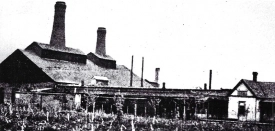HISTORY
ABOUT US
OUR HISTORY
Like many other glass tableware plants in the 1890s, the Indiana Tumbler and Goblet factory at Greentown, Indiana, came about because of the confluence of various historical events and key personalities—a town eager for industrial development; seemingly abundant natural gas; citizens willing to invest funds; and an experienced glassman with an entrepreneurial spirit.

The citizens of Greentown had been actively seeking industrial development for about two years. The Greentown Improvement Association was formed in early 1892, and the weekly Kokomo Dispatch (March 10, 1892) said that its purposes were “to advertise Greentown, secure funds for the location of factories, and labor diligently and disinterestedly for the upbuilding of our plucky little neighbor on the east.” A committee of three men—William Reed, Walter Templin, and Anderson Willits—called upon Greentown citizens and solicited $5.00 subscriptions to accomplish these ends. The Kokomo newspaper also had this to say: “Greentown is surrounded by the most prolific natural gas field in all Christendom and with an organized effort should be able to make rapid strides forward.”
Construction moved quickly in March- April of 1894, and the main factory buildings, including a barrel-making shop, were completed by May 1. In early April, the Kokomo Dispatch reported “We are booming this morning. More hands at work at the factory slinging brick and laying mortar that you can shake a stick at.” The first glass was pressed in 1894 and the factory’s first expansion occurred during the summer of 1897. This expansion added warehouse and storage space, but, more importantly, it increased the firm’s glass melting capacity by adding several tank furnaces, which were called “roaring gimlets” by the glassworkers. These were “day tanks,” which require about 18-24 hours to melt more than a ton of batch.
In mid-1899, the Indiana Tumbler and Goblet Company was absorbed into the National Glass Co., a newly-formed combine that embraced nineteen glass tableware factories in Pennsylvania, Maryland, West Virginia, Ohio, and Indiana. The major player in the National Glass Co. was the McKee and Brothers firm of Jeannette, Pa. (note the correct spelling: “McKee” not “Mckee”!). The other member plants ranged from the huge Rochester Tumbler Co. in Pennsylvania to the relatively small Robinson Glass Co. in Zanesville, Ohio, and the Central Glass Co. in Summitville, Indiana.
The merger brought Jacob Rosenthal, the glass chemist to Greentown. Rosenthal was responsible for bringing Chocolate Glass and Golden Agate Glass to the factory in Greentown which became extremely popular and great sellers for the factory.
On Saturday, June 13, 1903, the Indiana Tumbler and Goblet Works at Greentown was destroyed by fire. By all accounts, the blaze began about noon, just after the glassworkers on the Saturday morning turn had finished their work and left the plant. The Kokomo Daily Tribune (June 13, 1903) fixed the cause of the fire as “chemicals … carelessly handled.” The available firefighting equipment at Greentown was hardly sufficient to counter such a blaze and the factory burnt to the ground.
Despite some efforts by Greentown citizens to seek investors to build another glass plant, this chapter in the town’s history had come to a sudden end. The parent National Glass Co. was itself in financial straits, and its woes were compounded further a few months later when the Royal Glass Works plant at Marietta, Ohio, was destroyed by fire in the early morning of Thanksgiving Day, 1903.
Our Publications
This information can be found in the NGGA’s official publication, “Greentown Glass, A Collector’s Guide”.
Contact Us
Send Message
Address
Greentown, IN 46936
